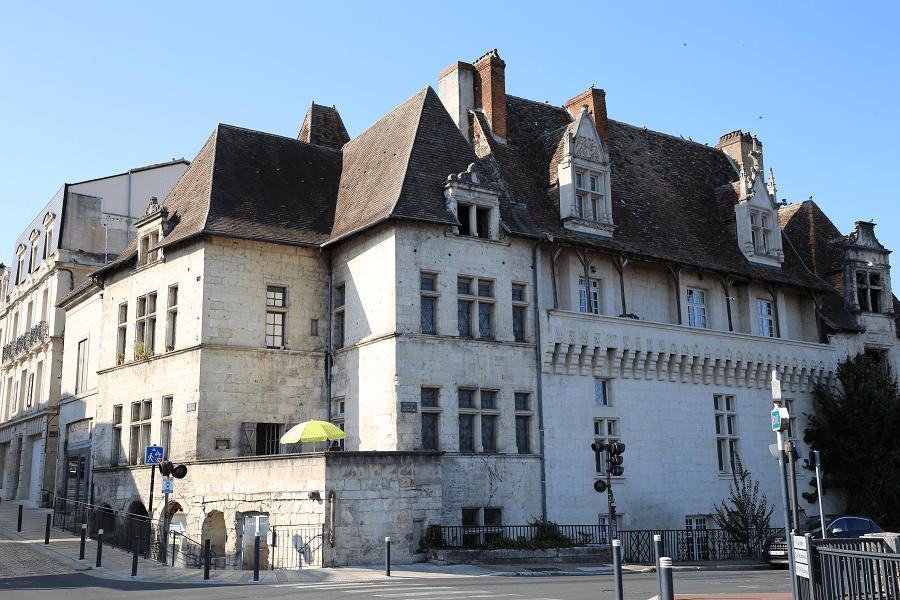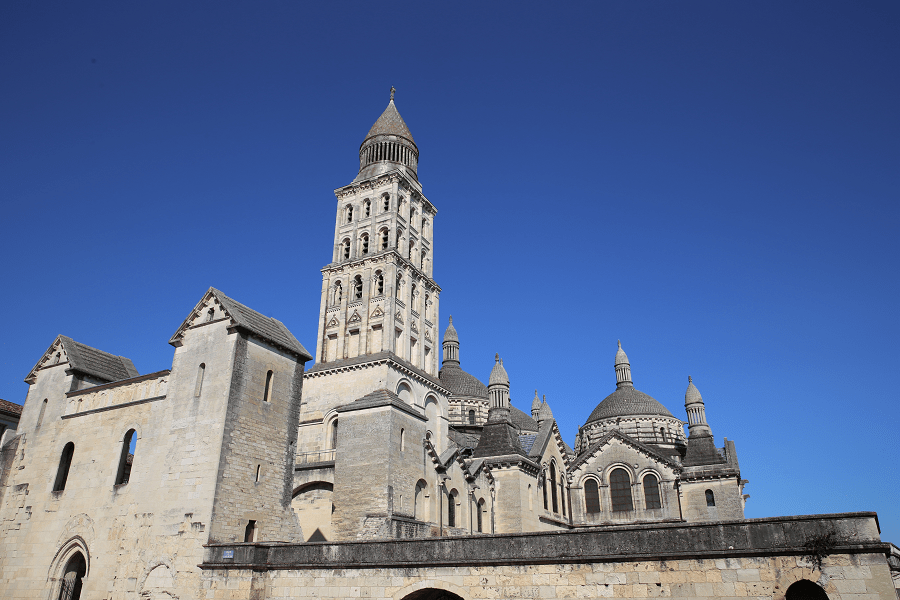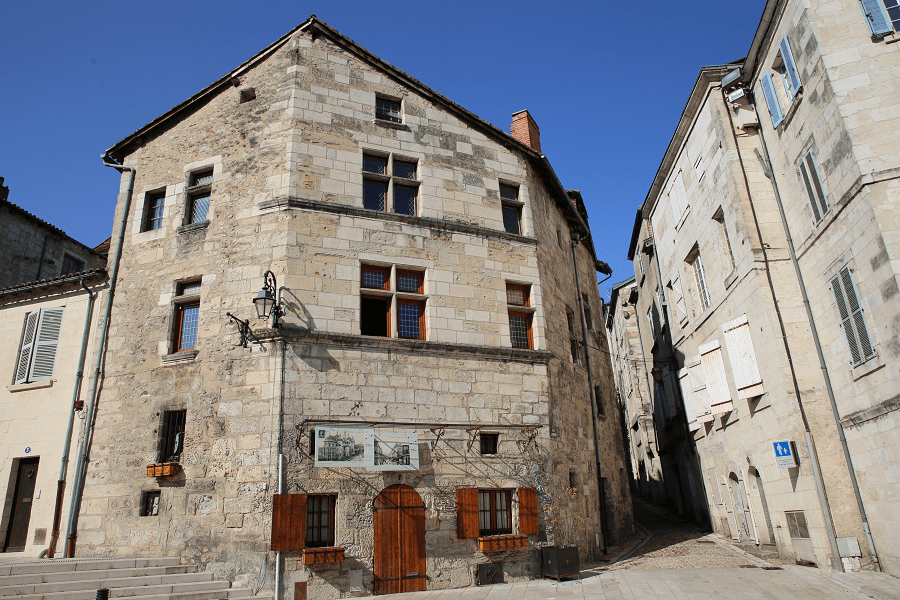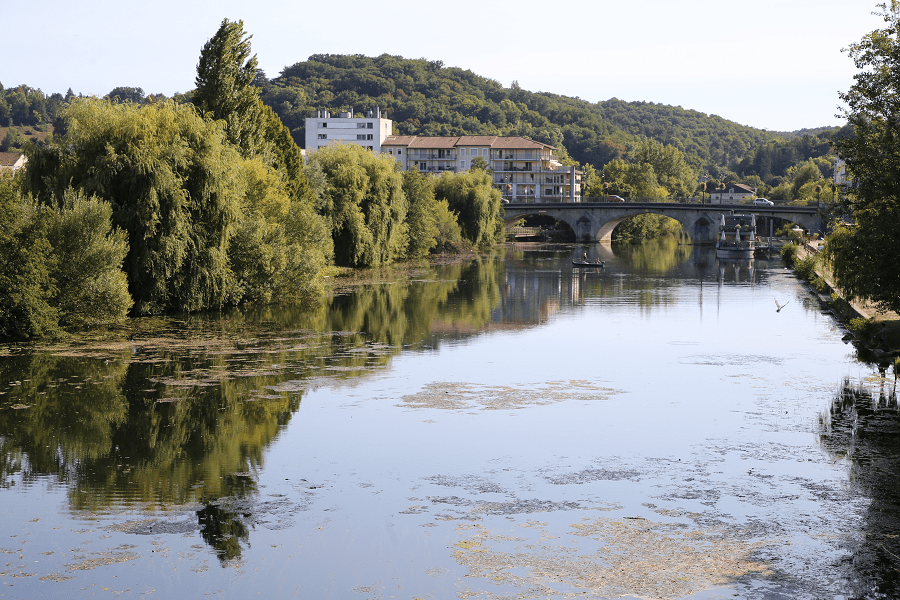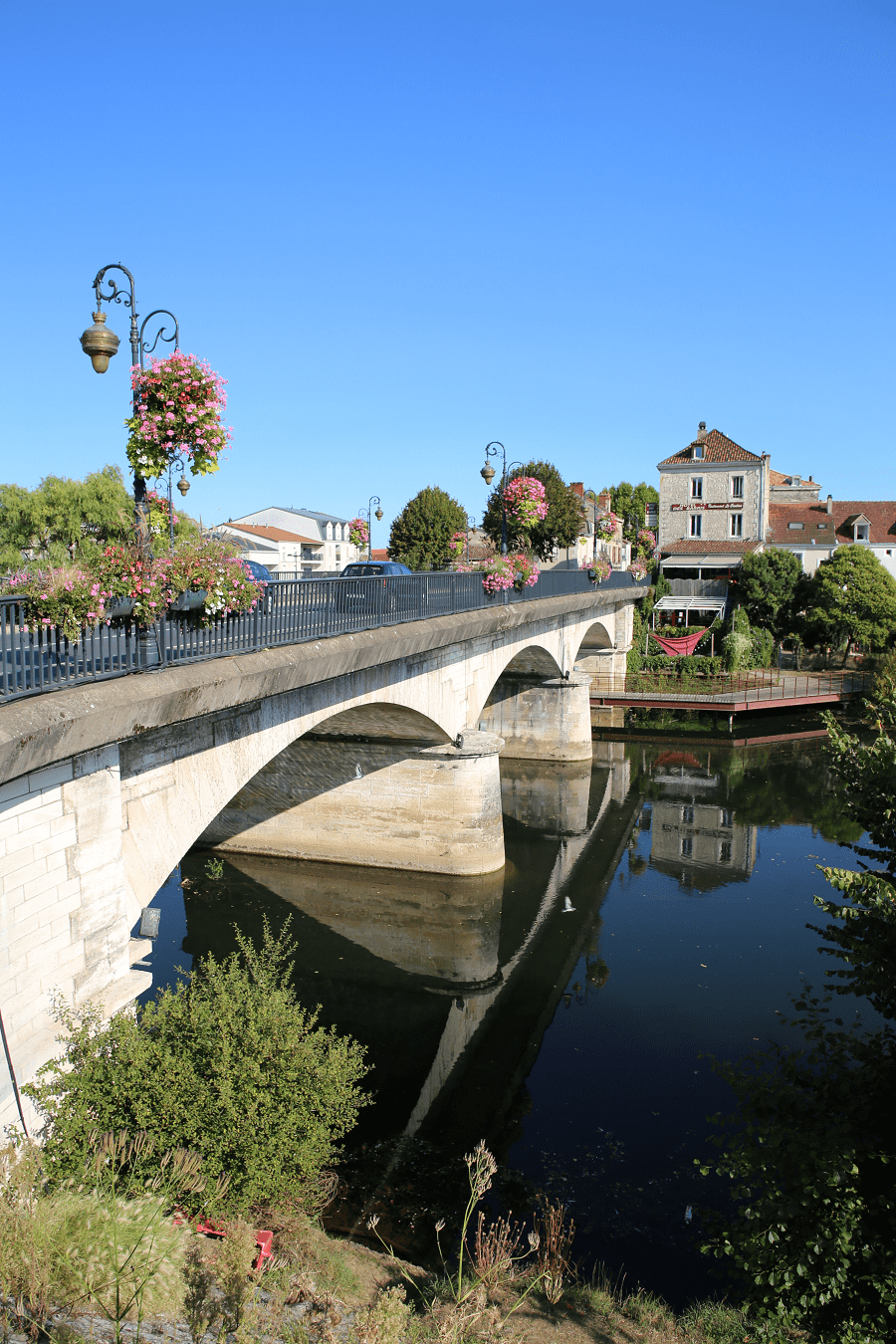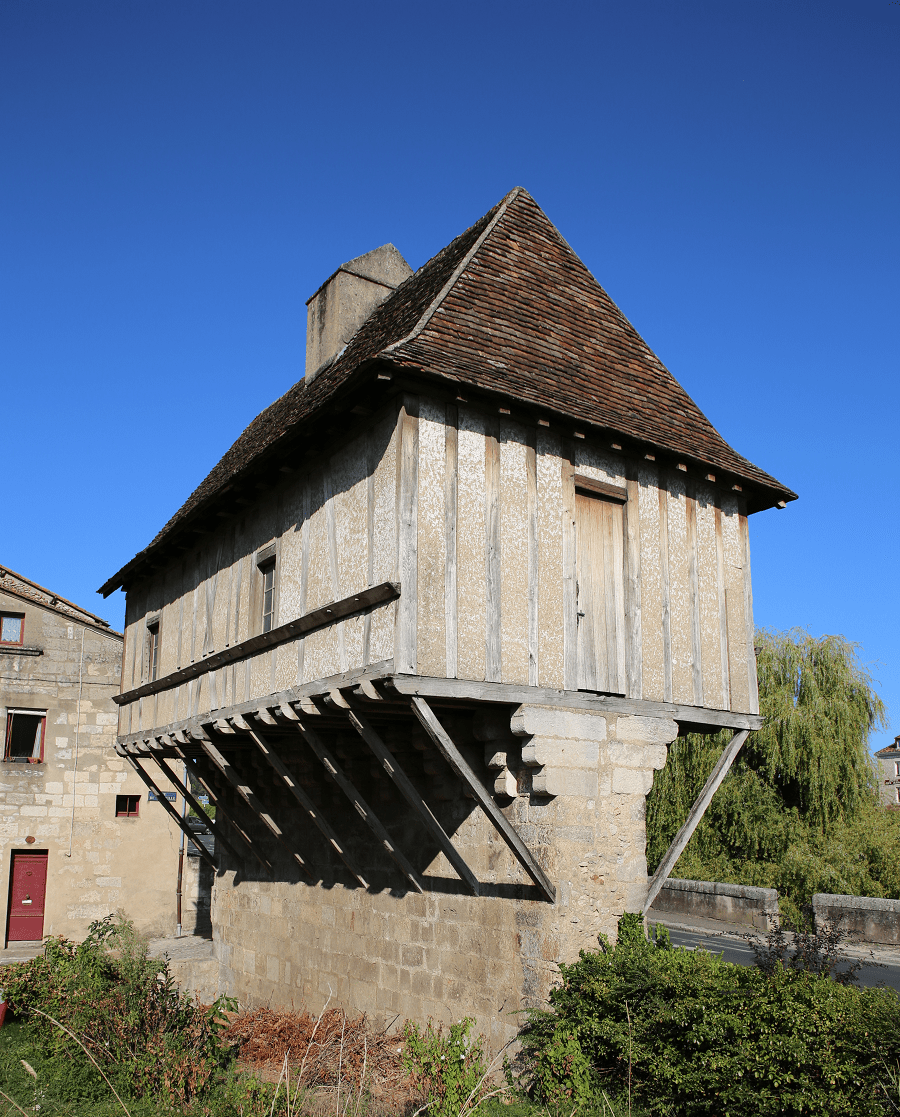Périgueux (Fr. Périgueux) is a French commune, the most populous of Périgord, located in the center-east of the Nouvelle-Aquitaine region. Capital of the Dordogne department since 1791. The urban unit of Périgueux is the ninety-sixth most populous urban unit in France.
Labelled “four flowers”, Périgueux is the cultural and tourist capital of the Périgord blanc, in the Isle valley. The city offers tourists a historical Gallo-Roman, medieval and Renaissance heritage. Recognized as a city of Art and History, Périgueux has 44 registered or classified historical monuments, and three museums labelled Museums of France, two of which are municipal. The city preserves and enhances its rich civil, military and religious heritage, including its Saint-Front cathedral, listed as historical monuments and as a UNESCO World Heritage Site.
The city dates from the first century BC. AD, during the Roman occupation in Gaul: the Romans settled in the plain of Isle and created the city of Vesunna, on the site of the current southern district. This was the Roman capital of the city of the Petrocores. The city of Périgueux was born in 1240 from the union of “the City” (the ancient Vesunna) and “Puy-Saint-Front”. Since then, it remains the centre of Périgord, historic subdivision of Aquitaine, then is the prefecture of the French department of Dordogne. It grew again in 1813 with the former municipality of Saint-Martin.
In economic terms, Périgueux, the centre of the department’s main employment area, is home to the head offices of several regional companies. The town has an employer of some 700 employees, the “Toulon workshops” of the SNCF. Benefiting from tourism for its heritage, it is also a notable gastronomic stopover in the heart of Périgord. Various cultural festivities and sports competitions are organized to liven up the region.
Its inhabitants are called the Périgourdins, sometimes the Pétrocoriens, a name taken from the people who had Vesunna as their capital.
Tourism and main attractions
The main symbol of the city is the Périgueux Cathedral. A cathedral since 1669, it is dedicated to Saint Front. The cathedral’s predecessor, still in operation as a church, is dedicated to Saint Stephen. A church was first built on the site in the fourth and fifth centuries.
In 976 the Bishop Frotaire had the Abbey of Saint-Front constructed on the site of the church. The abbey was consecrated in 1047. Its vaulted choir housed the tomb of Saint Front, which was sculpted in 1077 by Guimaunond, a monk of the abbey of Chaise-Dieu. This tomb was decorated with many precious stones and sculptures, notably an angel with a halo made of pieces of glass and is now kept in the Périgord Museum.
The cathedral owes its name to Saint Front, the first bishop of Périgueux. The cathedral, in either building, was and is the seat of the Bishop of Périgueux and Sarlat, as the diocese has been known since 1854.
The cathedral has been part of the World Heritage Sites of the Routes of Santiago de Compostela in France since 1998.
The city of Périgueux conceals the Gallo-Roman remains of the ancient city of Vésone: the remains of the domus des Bouquets (Gallo-Roman villa) above which the architect Jean Nouvel built the Vesunna museum. These remains have been classified as historical monuments since 1963.
The Jardin des Arènes is surrounded by the remains of the second century Roman amphitheatre, classified in 1840.
The tower of Vésone, classified in 1846, remains the only vestige of a fanum dedicated to Vésone, tutelary goddess of the city. This tower corresponds to the cella, which is the sacred central part where only priests had access.
Different remains of the Gallo-Roman citadel of Vésone were the subject of successive classifications in 1886, 1889 and 1942.
The city has preserved many medieval and Renaissance buildings: the Barrière castle, from the twelfth to the sixteenth century, listed as a historic monument since 1862, is built on the ancient wall built at the beginning of the third century.
Next to it is a building built above the Gallo-Roman wall and which was called Château d’Angoulême in the fifteenth century.
Over twenty hectares stretches the protected area of the medieval and Renaissance town centre, including Rue Limogeanne, notably with the Hôtel Fayard known as “Maison Estignard” and a group of houses from the Renaissance period.
The Mataguerre tower, the last existing tower of the rampart, is accessible for visitors. It has been listed since 1840.
On the banks of the river, near the cathedral, the Quays houses form an architectural ensemble made up of three adjoining houses, the Salleton hotel listed in 1938, the Consul’s house and the Lambert house, both classified since 1889.
Also, on the banks of the Isle, a strange cob and half-timbered building, the eschif. Although never used as a mill, the eschif is wrongly called “Old mill” or “Chapter mill” or “Saint-Front mill”. The confusion comes from the nearby Saint-Front mill which was in the middle of the Isle and which was demolished in 1860, seems to be miraculously standing on its base.
The Dordogne Prefecture Hotel, built in the nineteenth century, has a Second Empire facade; its salons are real works of art. It has been listed as a historical monument since 1975. The neoclassical-style courthouse has been partially registered since 1997.
On the banks of the Isle, 200 meters north-east of the cathedral, the seventeenth century Hôtel de Fayolle has been listed since 1970 for its porch.
Less than a hundred meters from the cathedral, the Masonic Lodge, inscribed in 1975 for its facades and roofs, offers Moorish-Balkan style facades.
Museums
The city has three museums, all of which have the name Musée de France because of the quality of their collections.
The Périgord art and archeology museum, the first museum in the department, was created in 1835.
The Périgord military museum was created in 1911 to keep in memory the heroism of the Périgueux National Guard and the 22nd Mobiles Regiment of the Dordogne from 1870 and 1871.
The Gallo-Roman museum Vesunna is a recent creation by the architect Jean Nouvel.
Together, they make it possible to understand local history through archaeological collections from prehistory to the present day.
The first also has fine collections from Africa and Oceania, items brought back by the Périgord during their travels since the middle of the nineteenth century.
Gastronomy and the best restaurants
The Périgueux pâté, already known at the end of the fifteenth century, is made of stuffing, foie gras and truffle.
Périgueux sauce is a roux that can also combine truffle and foie gras.
Apart from these two specialties, there is no traditional Périgord gastronomy. But because the city is part of Périgord, the restaurants and shops offer the culinary specialties of the region.
Among these are found in particular the Périgord walnut (AOC), produced in large quantities, and the chicken with rouilleuse sauce, typical of the South-West of France, which owes its name to a sauce made from wine and blood.
Crunchy Périgord, a dry biscuit often made with almonds, can also be tasted, as well as cricket, a pâté close to rillettes.
Tourin, which is a garlic, onion or tomato soup, is another specialty of the region.
Périgord mique, a leavened dough made from wheat flour, eggs, milk and fat (butter or duck fat), can also be tasted in the city. It is similar to that of the Limousin region.
In Périgueux, the international gourmet book fair is a biennial gastronomic festival taking place in November, which brings together cooks and “gourmands” to present them shows and exhibitions related to gastronomy.
There are eight Michelin list restaurants in Périgueux:
- Un Parfum de Gourmandise, 67 cours Saint-Georges, 35 – 80 EUR • Creative (one star)
- Cuisine & Passion, 7 place du 8 Mai-1945, 23 – 66 EUR • Modern Cuisine, Creative
- La Taula, 3 rue Denfert-Rochereau, 35 – 52 EUR • Regional Cuisine
- L’Essentiel, 8 rue de la Clarté, 49 – 110 EUR • Modern Cuisine (one star)
- Hercule Poireau, 2 rue de la Nation, 21 – 60 EUR • Modern Cuisine
- Café Louise, 10 place de l’Ancien-Hôtel-de-Ville, 24 – 49 EUR • Italian
- L’Épicurien, 1 rue du Conseil, 38 – 79 EUR • Modern Cuisine
- L’Atelier, 2 rue Voltaire, Périgueux, 24 – 69 EUR • Modern Cuisine
Shopping
The best day to visit Perigueux is Saturday when the colourful market is held in the Place de la Clautre.
Transport and how to get to?
Périgueux – Bassillac Airport is an airport in the village of Bassillac in the Dordogne department, Nouvelle-Aquitaine region, France. It is located 8 kilometres east-northeast of the town of Périgueux, which manages the airport.
The Gare de Périgueux is the railway station in the town of Périgueux. The station opened in 1857 and is located on the Limoges-Bénédictins – Périgueux and Coutras – Tulle railway lines. The station is served by Intercités (Long distance) and TER (regional) services operated by SNCF, the French national railway.
Distances by car:
From Nantes (tolls): 4 h 9 min (358 km) via A83
From La Rochelle (tolls): 2 h 48 min (273 km) via A10 and A89
From Bordeaux (tolls): 1 h 32 min (132 km) via A89
From Dax (tolls): 2 h 50 min (278 km) via A63 and A89
From Bayonne (tolls): 3 h 5 min (316 km) via A63 and A89
From Biarritz (tolls): 3 h 14 min (330 km) via A63 and A89
From Saumur (tolls): 3 h 49 min (287 km) via N10 and D939
From Toulouse (tolls): 2 h 49 min (278 km) via A20 and A89
From Marseille (tolls): 6 h 26 min (678 km) via A20
From Nice (tolls): 8 h 7 min (836 km) via A8
From Monaco (tolls): 8 h 24 min (857 km) via A8
From Perpignan (tolls): 4 h 37 min (482 km) via A61 and A20
From Andorra (tolls): 5 h 12 min (459 km) via A20
Main information
Area: 9.82 sq. km
Population: 30 000
Languages: French
Currency: euro
Visa: Schengen
Time: Central European UTC +1
GPS coordinates: 45° 11′ 02″ N, 0° 42′ 57″ E




